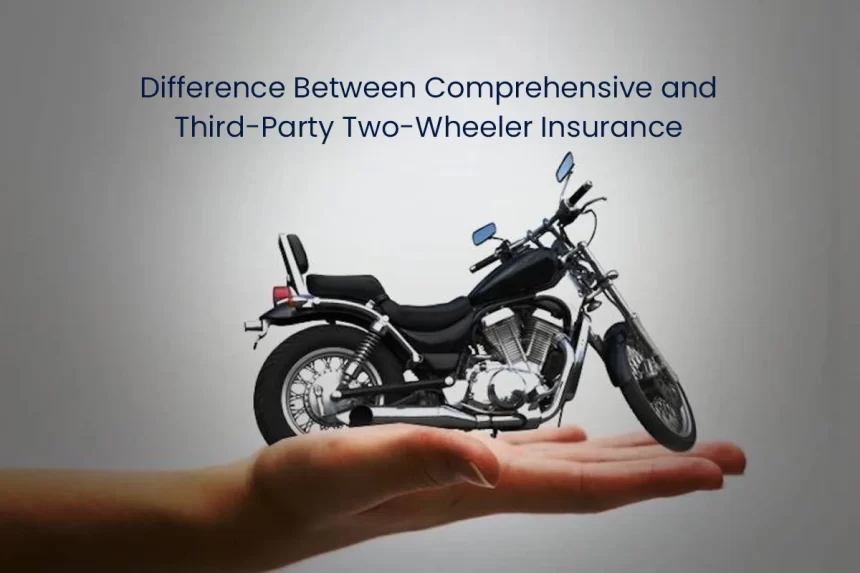Two-wheeler insurance is a critical aspect of owning a bike or scooter, ensuring financial protection in case of accidents, theft, or damages. There are two primary types of insurance available for two-wheelers: comprehensive insurance and third-party insurance. While both offer protection, they differ significantly in terms of coverage, cost, and benefits. This blog post will explore the difference between comprehensive and third-party two-wheeler insurance in a detailed, step-by-step manner with examples to help you make an informed decision.
Introduction to Two-Wheeler Insurance

Insurance is mandatory for all motor vehicles, including two-wheelers, in most countries. The purpose of insurance is to cover financial liabilities that may arise from accidents, damages, or theft. When it comes to insuring two-wheelers, vehicle owners have two primary choices: third-party insurance and comprehensive insurance. Understanding the differences between these two options is essential for selecting the one that suits your needs best.
Step-by-Step Guide to Understanding the Difference Between Comprehensive and Third-Party Two-Wheeler Insurance
| Category | Third-Party Insurance | Comprehensive Insurance |
|---|---|---|
| Coverage | Limited coverage that only includes third-party liabilities. It does not protect your own vehicle or personal injuries. | Extensive coverage that includes third-party liabilities, damages to your vehicle, theft, fire, natural calamities, and personal injuries. |
| Legal Requirement | Legally mandatory for all two-wheeler owners. You cannot ride a bike or scooter without at least this type of insurance. | Not mandatory by law, but highly recommended for broader protection. |
| Premium Cost | The premium is lower because of the limited coverage it offers. | The premium is higher due to the extensive coverage, including own damage and personal accident cover. |
| Claim Process | The claim process involves the third party proving that the policyholder was at fault, which can sometimes be a lengthy legal process. | The policyholder can claim for both third-party liabilities and their own damages, making the process quicker and more efficient. |
| Add-On Covers | No add-ons are available since the coverage is minimal. | Multiple add-ons like zero depreciation, roadside assistance, and engine protection are available to enhance the coverage. |
What Is Third-Party Two-Wheeler Insurance?
Third-party insurance is the most basic and legally mandatory type of insurance. It covers the financial liabilities that may arise if your two-wheeler causes injury, death, or property damage to a third party. However, it does not cover damages to your vehicle or any personal injuries.
Key Features of Third-Party Insurance:
- Liability Coverage: Covers damages or injuries caused to a third party.
- Legally Mandatory: Most countries require third-party insurance for all motor vehicles.
- No Coverage for Own Damage: Does not cover damages to your own vehicle or personal injuries.
- Affordable: Since it offers minimal coverage, it is more affordable than comprehensive insurance.
Example of Third-Party Insurance:
Imagine you are riding your two-wheeler and accidentally hit a pedestrian or another vehicle. In this case, your third-party insurance will cover the medical expenses of the injured party or the repair costs of the damaged vehicle. However, any damage to your own two-wheeler will not be covered under this policy.
What Is Comprehensive Two-Wheeler Insurance?
Comprehensive Two-Wheeler Insurance provides broader coverage, protecting not only against third-party liabilities but also damages to your own vehicle, theft, and personal injuries. It is more expensive than third-party insurance but offers extensive protection.
Key Features of Comprehensive Insurance:
- Third-Party Liability Coverage: Covers damages or injuries caused to a third party, similar to third-party insurance.
- Own Damage Coverage: Covers damages to your two-wheeler, whether from accidents, theft, fire, or natural calamities.
- Personal Accident Coverage: Offers financial protection in case of personal injury or death.
- Add-Ons: You can enhance the policy with add-ons like zero depreciation, engine protection, and roadside assistance.
Example of Comprehensive Insurance:
Suppose you are involved in an accident where both your two-wheeler and the third party’s vehicle are damaged. In this scenario, your comprehensive insurance will cover the repair costs of both vehicles. Additionally, if your two-wheeler is stolen or damaged due to natural calamities, the insurance will also provide financial compensation.
Difference in Coverage Between Third-Party and Comprehensive Bike Insurance
| What is Covered in Third-Party Bike Insurance | What is Not Covered in Third-Party Bike Insurance |
|---|---|
| Third-Party Liabilities | Own Damage Cover |
| Third-party Damages | Damage While Transporting Your Bike |
| NO Add-Ons | Injuries You Sustain |
| Legal Costs You Incur | Driving While Intoxicated |
| Theft or Natural Disasters |
| What is Covered in Comprehensive Bike Insurance? | What is Not Covered in Comprehensive Bike Insurance? |
|---|---|
| Third-Party Liabilities | Driving While Intoxicated |
| Own Damage Cover | Commiting Illegal Acts |
| Damage While Transporting Your Bike | Driving Without a License |
| Personal Accident Cover | Negligent Driving |
| Add-Ons | Damage caused by Warfare or Nuclear Events |
| Injuries You Sustain | Depreciation (without add-on) |
Advantages and Disadvantages of Third-Party Insurance
Advantages:
- Affordability: The most affordable type of insurance, suitable for those on a tight budget.
- Legal Compliance: Meets the legal requirement for two-wheeler insurance.
Disadvantages:
- Limited Coverage: Offers no protection for your own vehicle or personal injuries.
- No Add-Ons: This cannot be enhanced with additional coverage options.
Advantages and Disadvantages of Comprehensive Insurance
Advantages:
- Extensive Coverage: Protects against third-party liabilities, own damage, theft, natural calamities, and personal injuries.
- Add-Ons Available: This can be customized with various add-ons to suit individual needs.
Disadvantages:
- Higher Premium: The cost is significantly higher than third-party insurance due to the broad coverage.
Real-World Example: Third-Party vs. Comprehensive Insurance
Third-Party Insurance Example:
Rajesh owns a scooter and opts for a basic third-party insurance plan. One day, he accidentally bumps into a parked car, causing a dent. The car owner makes a third-party insurance claim for the damages, and Rajesh’s third-party insurance covers the repair costs for the car. However, Rajesh’s scooter was also damaged, and since he only has third-party insurance, he must bear the repair costs for his own scooter.
Comprehensive Insurance Example:
On the other hand, Simran owns a motorcycle and has purchased comprehensive insurance. During a heavy storm, her motorcycle was damaged by a fallen tree. Since her insurance policy includes her own damage cover, Simran was able to claim for the repair costs. Additionally, if her bike had been stolen during the storm, her comprehensive insurance would have covered the loss.
When Should You Choose Third-Party Insurance?
Third-Party Insurance is ideal for:
- Individuals who want to meet the legal requirement but do not need coverage for their own vehicle.
- Riders with older or low-value bikes, where the cost of repairs may not justify a comprehensive policy.
- Those who are on a tight budget and need the most affordable insurance option.
When Should You Choose Comprehensive Insurance?
Comprehensive insurance is ideal for:
- Individuals who want full protection for their two-wheeler, including third-party liabilities, own damage, and theft.
- Owners of new or high-value bikes, where the cost of repairs or replacement is significant.
- Riders who live in areas prone to natural disasters or have a higher risk of theft.
Add-Ons to Enhance Comprehensive Insurance
- This add-on ensures that you receive the full value of parts to be replaced without any depreciation deduction during a claim.
2. Engine Protection Cover:
- Covers engine damage caused by water ingress, leakage of lubricants, or other mechanical issues not covered under the standard policy.
3. Roadside Assistance Cover:
- Provides 24/7 assistance in case of a breakdown or emergency, including towing, minor repairs, and fuel delivery.
4. Consumables Cover:
- Covers the cost of consumables like engine oil, nuts, bolts, and screws, which are typically excluded from standard policies.
5. Personal Accident Cover for Co-Riders:
- It extends personal accident coverage to the co-rider in case of an accident.
Final Thoughts: Difference Between Comprehensive and Third-Party Two-Wheeler Insurance
In conclusion, the difference between comprehensive and third-party two-wheeler insurance is primarily based on the extent of coverage. While third-party insurance is affordable and legally mandatory, it offers minimal protection and does not cover your own vehicle or personal injuries. On the other hand, comprehensive insurance provides extensive coverage, including third-party liabilities, own damage, and theft, but comes with a higher premium.
If you’re looking for peace of mind and complete protection for your two-wheeler, comprehensive insurance is the better option. However, if you’re on a budget and only need basic legal protection, third-party insurance will suffice.
Understanding these differences and assessing your individual needs will help you make an informed decision when choosing between comprehensive and third-party two-wheeler insurance. Keep reading blogs on AUTOLIVENEWS to know how to check bike insurance, how to renew expired insurance, and more!
Frequently Asked Questions (FAQs)
What is third-party two-wheeler insurance?
It covers only third-party liabilities like injuries, death, or property damage caused to others by your two-wheeler.
What is comprehensive two-wheeler insurance?
It provides coverage for third-party liabilities as well as damages to your own vehicle, theft, and personal injuries.
Is third-party insurance mandatory?
Yes, it is legally mandatory in most countries for all two-wheelers.
Which insurance is cheaper: third-party or comprehensive?
Third-party insurance is generally cheaper due to its limited coverage.
Can I upgrade from third-party to comprehensive insurance?
Yes, you can upgrade at the time of renewal or by contacting your insurer.
What are add-ons in comprehensive insurance?
Add-ons are additional covers like zero depreciation, engine protection, and roadside assistance that enhance your policy.
What happens if my bike is stolen and I have third-party insurance?
Third-party insurance does not cover theft. Only comprehensive insurance will cover theft.
Is it worth buying comprehensive insurance for an old bike?
It depends on the bike’s value. If the repair or replacement cost is high, comprehensive insurance is advisable.
Does third-party insurance cover personal injuries?
No, it only covers injuries to third parties. Comprehensive insurance includes personal accident coverage.
How can I reduce the premium for comprehensive insurance?
Opt for voluntary deductibles, avoid small claims, and install anti-theft devices to reduce the premium.















